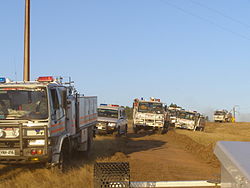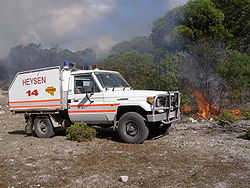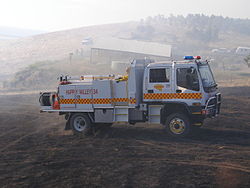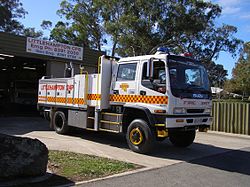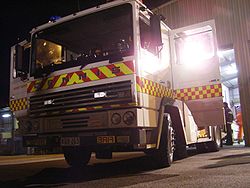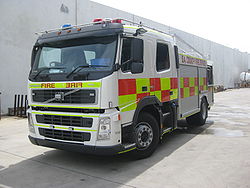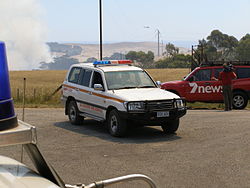- Country Fire Service appliances
-
Country Fire Service appliances used by the CFS (or SACFS) in the state of South Australia are provided and funded by the South Australian Government, and by donations from the public. As the funding model of government funding is relatively new, the standard for SACFS appliances is still only new, and many appliances still exist that were built by the individual brigades. Because of this, almost all appliances are unique, and hence cannot be described simply. However, the SACFS has managed a standard naming convention of all SACFS appliances, and also a basic standard stowage of equipment that can be found on all appliances.
Contents
Understanding the SA Country Fire Services appliances
All SA Country Fire Service appliances have a call sign, which is the name of that appliance. This consists of the brigades name, usually the town it serves) and a keyword to describe the type of appliance. The appliance's call sign will be printed clearly on the side of appliance, and often on the back and roof of the appliance. (Appliances are more commonly known as trucks, and units (units being the name used by the EFS))
Most SACFS appliances have names based on their water capacity, and drivetrain. A 24 (Two Four) appliance carries 2000 litres of water, and is a 4 wheel drive chassis. The figures are for nominal water capacity, rather than the exact amount carried. Other, more specialised appliances are named after their purpose, such as Pumper, Rescue, Hazmat, or Tanker (BWC).
All Country Fire Service appliances are white, with fluorescent red and white striping (on older appliances), or red and gold chequering, called Sillitoe Tartan, on new appliances. Like all emergency vehicles in South Australia, all CFS appliances are fitted with red and blue flashing lights, with the exclusion of the Kyeema BWC. (Some appliances also have white flashing lights or traffic clearer's on the front).
Stowage
SACFS appliances are set up with different stowage depending on what assets they protect, whether they are urban or rural, and whether they serve a special purpose (For example, Rescue stowage). Appliances will have a basic stowage which is then added to by the brigade for a specialised purpose, or to fit the type of appliance.
Basic rural appliance standard stowage
All rural appliances should have the following stowage:
- Rubber hose line (side line)
- 25 mm canvas "Lay-flat" hose
- 38 mm canvas hose
- 64 mm canvas hose
- Suction hoses
- Bush Fire Fighting Foam (BFFF)
- First aid kit
- Standpipe and key
- Fire lighters for lighting back burns
- Rakehoes
- Shovels
- Rope
- Knapsack spays
- GRN radios
- VHF and/or UHF radios
- Traffic cones
- Safety vests
- Halligan tool
- Torches
- Maps (street directories or topographical maps)
Basic urban appliance standard stowage
Urban stowage is very similar to rural, with the addition of further "urban" equipment, for house fires, and vehicle fires. An urban appliance will also carry more of the larger hoses (38 mm and 64 mm). Urban standard stowage includes:
- Rural standard stowage
- Rubber hoses (in lieu of Canvas)
- Assorted branches
- Assorted extinguishers
- Fire Fighting Foam (AFFF)
- Tool kit
- Breathing Apparatus'
- Portable lighting equipment
- Generator
- Chainsaw
- Ceiling pike (or pike pole)
- Salvage sheets
- Absorbent material (for oil spills etc.)
Basic rescue standard stowage
Appliances that are built for Road Crash Rescue must have a minimum set of rescue equipment, which includes:
- Hydraulic Road Crash Rescue Equipment including:
- Hydraulic cutters
- Hydraulic spreaders
- Hydraulic rams (Of various sizes)
- Hand tools including:
- Halligan tool
- Glass removal tools and shields
- Toolbox with spanners, hammers, screwdrivers etc.
- Wooden blocks and chocks (for stabilisation)
- Sharps protection (materials with which to cover sharp edges)
- Generator and additional lighting
- Ladder
- Chainsaw
- First aid kit
- Dry powder and/or CO2 and/or foam extinguishers
- Safety vests
- Traffic cones
- Salvage sheets/tarpaulins
- Stop/Slow bats for traffic control
- GRN radios
- VHF and/or UHF hand radios
Basic HAZMAT stowage
- T-Top cones and tape to set up a 'decontamination zone'
- Splash suits and/or gas suits and breathing apparatus for initial combatants.
- "Plug 'n Dike" putty and wedges for sealing leaks.
- Soft bristle brooms for decontamination
- Salvage sheets for staging area
- The Initial Emergency Response Guide (IERG) which has information on most common chemicals
- Other paperwork to keep record of who has been exposed to the substance, and what the substance is, and how to deal with it.
Further stowage
In addition to the standard stowage, equipment on appliances may include:
- Chainsaw
- GPS
- 100 mm suction hose
- Positive pressure ventilation fan (PPV fan)
- Trauma teddy
- Stop/Slow bats for traffic control (added to rural appliances)
- Assorted hand tools such as axes, sledgehammers, hammers, screwdrivers, bow saws, etc.
- Oxygen kit
- Salvage sheets
- "Rapid Intervention" hydraulic cutter/spread combination tool
- "Rapid Intervention" battery powered reciprocating saws/drills
- Floating collar dam
CFS appliances
The CFS has the following types of appliances in service:
Rural appliances
The first number of the type is the category number while the second number indicates two or four wheel drive.
- QAV, 14 and QRV - One-four appliances are very useful in South Australia, especially throughout the Mount Lofty rangers. This is because 14 appliances are small and able to get up small tracks, unlike other larger trucks, as listed below. There are two types of one four appliances, firstly there is one which is made on a Utes body, and there is another type which is becoming more common using Mitsubishi Canters. A QAV (Quick Attack Vehicle) is a lot like a 14, but often carries less water. A QAV is good to put out fires in hard to reach places, where a normal truck will not reach. Both carry the rural stowage. QRV (Quick Response Vehicle) are a new line of quick response vehicles used primarily for swift response to small going grass fires, vehicle accidents or to go up steep driveways or tracks like there are around the Mount Lofty Ranges. A QRV carries only 550 litres of water but is ideal if located near to a fire hydrant or if responded with a larger urban appliance like a 24 or 34.
- 22 - These trucks are quite rare, and are not being used much in the CFS, due to their being rural appliances having only two wheel drive. They were never popular for this reason, and only three remain operational.
- 24 - The 24 (pronounced two-four) appliance is the most common appliance in operation in the CFS. During the early 1990s the CFS purchased a substantial number of Hino truck chassis for the 24 appliances. The 24s were popular at the time, as they carried a lot of water (2000 litres) and had the ability to drive on almost any type of terrain. With advances in engine technology, trucks can now carry even more water, and the CFS has opted towards 34s for the greater water capacity. Most 24s are single cab, meaning some fire fighters sit on the back deck of the truck, rather than being in the cabin. The 24 can carry a plain rural stowage, but will often have some urban stowage added on, like breathing apparatus and other structural fire equipment.
- 34 - The CFS's preferred appliance of 2005/2006, the 34, (pronounced three-four), carries 3000 litres and is a 4 wheel drive. The modern 34s are based on an Isuzu chassis and are dual cab. These 34s are very high, making them sometimes unsuitable for busfire fighting, especially on tight fire access tracks. Hence, they complement a 14 well.
- Tankers (bulk water carriers) - There are 19 tankers in service in the CFS, ranging from 7,000 litres to about 18,000 litres. The tanker's primary job at an incident is to ensure that water can be supplied to other fire fighting appliances. The tanker very rarely participates in actual fire suppression, but rather will set up near a static water source, and draught water for other appliances.
Semi-rural
- 24P - 24Ps (Two-Four-Pumpers) are often placed in quite large towns, which have large rural areas around them. Although they are not often used for a rural fire, they are quite capable of going off track to fight them. Most stations which have a 24P, often have another truck which is used for more rural jobs, such as a 24 or 34. The pump size on a 24P is not as large as the Urban appliances in the CFS, but it is quite capable of dealing with small house/commercial fires.
- Urban/rural pumper (URP) - The CFS has only one appliance designated "URP".
- 34P - A 34P is almost the same as a 24P, the only large difference being the amount of water (3,000 L). They can also carry more gear than a 24P, which is useful for urban trucks. There is a problem sometimes with the size of these trucks, as they sometimes have problems accessing driveways due to low branches.
- Urban - Urban appliances are appliances designed for incidents that occur in urban areas—that is, house fires, car fires, bin fires, vehicle accidents and other general urban rescues. All urban appliances have similar stowage, so their classification is tightly based on water capacity and pump capacity. The most recent urban appliances built by the CFS are based on the relatively cheap Isuzu cab chassis (750s or 900s).
- Pumpers - All pumpers have PTO-driven pumps, however some have auxiliary pumps for pump-and-roll capability. By the definition of volume in a pump (not counting pressure)
-
-
- 1000-2000 L/min = Light Pumper
- 2000-3000 Lmin = Medium Pumper
- 3000+ L/min = Heavy (real) Pumper
-
- 12 - There are only three 12 appliances left in service in the CFS. These are on Aldgate, Stirling and Upper Sturt. They carry 1000 litres of water and are 2 wheel drives. All are dual cabs, and PTO driven pumps.
- Medium urban pumper - The CFS has a handful of medium pumpers at stations around the state. From older models such as Stirling's prototype WA Fire pumper to the new generation of NSWFB Spec Izusu 'Type 2' pumpers. These newer pumpers can be found from Mt. Barker to Happy Valley, serving in communities where there is a high urban risk.
Morphett Vale Brigade's Dennis Heavy Pumper
- Heavy urban pumper - The SACFS currently has only two Heavy Pumpers. One is a secondhand imported Dennis from the UK. This appliance was station at Mt. Barker, then was moved to Seaford and is now based at Morphett Vale. The appliance carries a normal Urban stowage, with BA sets in the cabin of the truck to allow firefighters to don their safety equipment faster. The appliance also carries a set of Rapid Intervention Holmatro Hydraulic Rescue Equipment. The other appliance is the new Burnside Pumper, which is a Volvo FM9. This appliance carries 3000lt of water, carries full urban stowage, BA seats in the cabin, and a full set of Lukas road crash rescue equipment.
Specialised
- Hazmat - Hazmat appliances carry equipment needed to combat hazardous material spills and leaks. There are a few stand-alone Hazmat vehicles (including State Hazmat, the state Hazmat tender, housed at Burnside CFS) However most brigades stow their hazmat equipment on a multi-purpose appliance, like a Rescue/Hazmat or Pumper/Hazmat.
- Road crash rescue - There are 11 dedicated rescue tenders in service in the CFS, however there are also multi-purpose appliances like Pumper/Rescues.
Support vehicles
- Group command car
- Logistics Support Vehicle - The CFS use various logistic vehicles, these may range from large tray-back trucks to simple trailers. These logistic vehicles are used at large incidents for various purposes, but are generally used to transport food and drinking water to the fire ground. Equipment a Logistic Support Vehicle may carry could include:
- Floating collar dam
- Quick-Fill pump
- Food
- Drinking water in 12v fridge
- Extra radio Equipment
- Extra Firefighters
- Breathing apparatus compressor
- Extra Breathing apparatus cylinders
- Road Crash Rescue Equipment
- 240v Generator
- Lighting
- Comms bus - The CFS currently has Communication Buses at strategic locations around the state to allow rapid Incident Management response to incidents state wide.
- CABA/HAZMAT trailers
Aircraft
- Fixed wing bomber - Fixed wing bombers are small airplanes. They need to land at an airstrip to refill with water. These planes are often yellow. These planes when being filled up often have either foam or retardant mixed with the water. The pilots of these planes are very skilled and can sweep down very close to the ground or treetops to dump the water.
- Helicopter bombers - Heli-air bombers (heli-tak), are very practical because they are able to stay in the air, and fill up over water, without landing. They have a long hard suction line hanging out of the bottom on the helicopter, which they dip into water as they hover of it, and fill up. They are good for targeting specific objects, like houses, sheds, and vehicles in danger. They can also be used effectively to stop the spread of a scrub/grass fire if it has a very narrow front as they can drop their water much more accurately than the fixed-wing aircraft.
- Surveillance - Helicopter or fixed-wing aircraft used to "spot" fires—to provide feedback to the incident controller from the air about where the fire is, where it is going, and what problems fire fighters are likely to encounter. The Motor Accident Commission–sponsored rescue helicopters (Rescue 51 and Rescue 52) are often used for this.
Reference: http://www.cfs.sa.gov.au/site/about_us/aerial_firefighting/cfs_firefighting_aircraft.jsp
References
- Our Equipment, Country Fire Service
Gallery
Fire services in Australia Victoria New South Wales New South Wales Rural Fire Service · List of NSWRFS Brigades · NSWRFS Section 44 · Fire and Rescue NSW
South Australia Country Fire Service · CFS Appliances · Emergency Fire Service (Historical) · SA Metropolitan Fire Service
Queensland Queensland Fire and Rescue ServiceOther states &
national organisationsCategories:- Firefighting equipment
- Fire and Rescue services of Australia
Wikimedia Foundation. 2010.

